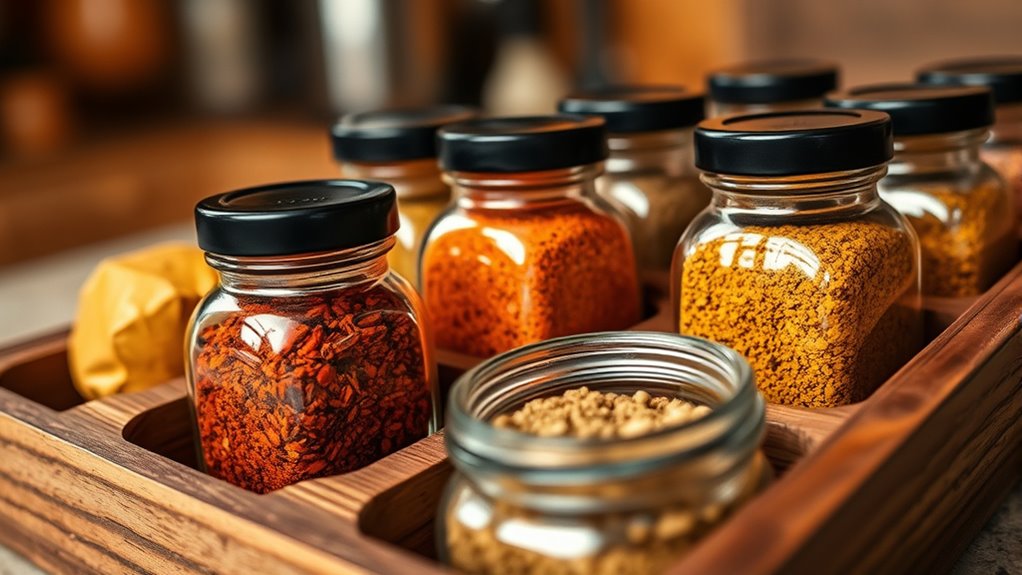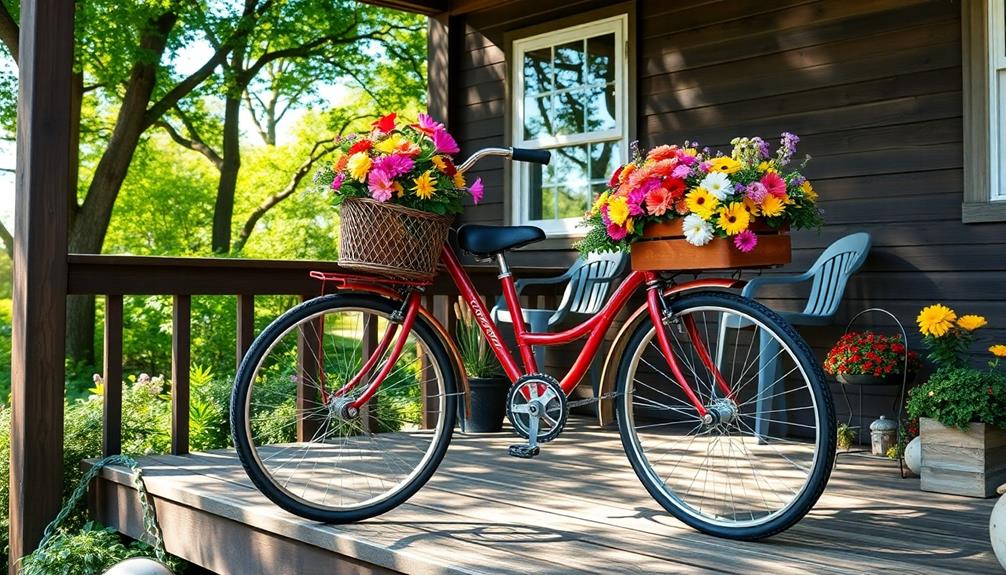To store spices longer, keep them in airtight, opaque containers placed in a cool, dark, and dry spot away from heat sources and sunlight. Proper labeling and FIFO rotation help maintain freshness, while avoiding humidity prevents clumping and spoilage. Store coffee and tea separately to prevent flavor transfer. Regularly check for signs of aging or dullness, and grind spices just before use for the best flavor. If you want to know more, there’s plenty to uncover.
Key Takeaways
- Store spices in airtight, opaque containers in cool, dark, and dry locations to prevent light, heat, and moisture damage.
- Keep spices away from heat sources and environmental fluctuations to maintain potency and extend shelf life.
- Regularly check for signs of spoilage and rotate stock using FIFO, discarding old or dull spices promptly.
- Grind spices just before use to maximize flavor and aroma, avoiding pre-ground spices that may be stale.
- Separate storage for coffee and tea in airtight containers prevents scent transfer and preserves their unique flavors.
Keep Spices Away From Light: the Secret to Preserving Aroma
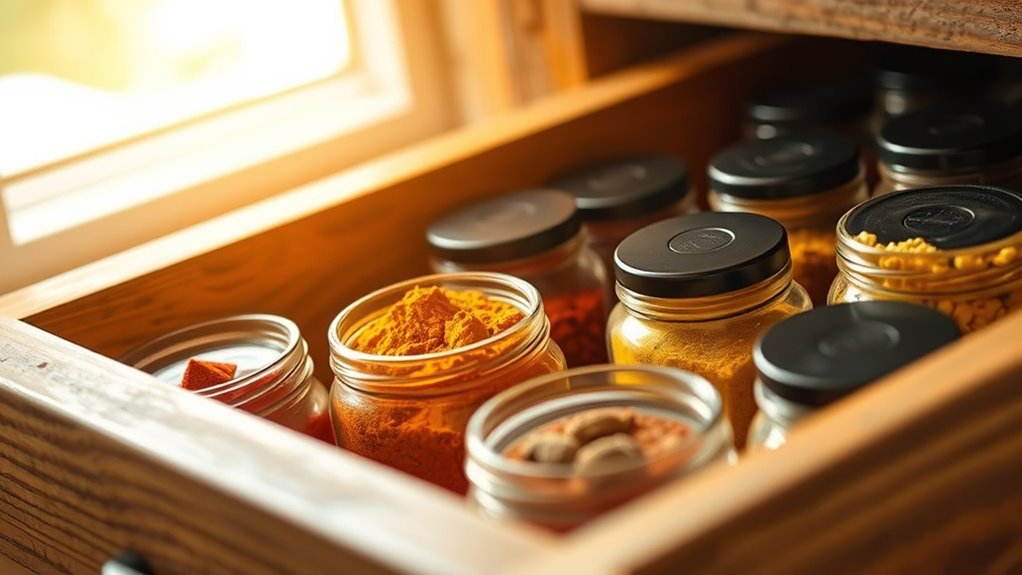
Light, especially sunlight, can quickly degrade the aroma and flavor of your spices. When exposed to light, spices lose their potency faster, making them less flavorful over time. To preserve their rich aroma, keep your spices in a dark, cool place away from windows and direct sunlight. Limiting light exposure is key to maintaining their freshness and ensuring you get the full flavor in every dish. Clear containers or shelves near windows accelerate aroma loss, so opt for opaque jars or store spices in a cabinet. Proper light protection prevents the breakdown of essential oils responsible for flavor and aroma. Additionally, proper storage conditions—such as temperature and humidity—also play a vital role in extending their shelf life. By shielding your spices from light, you considerably extend their shelf life and keep their vibrant, fragrant qualities intact longer.
Store in Airtight Containers for Maximum Freshness
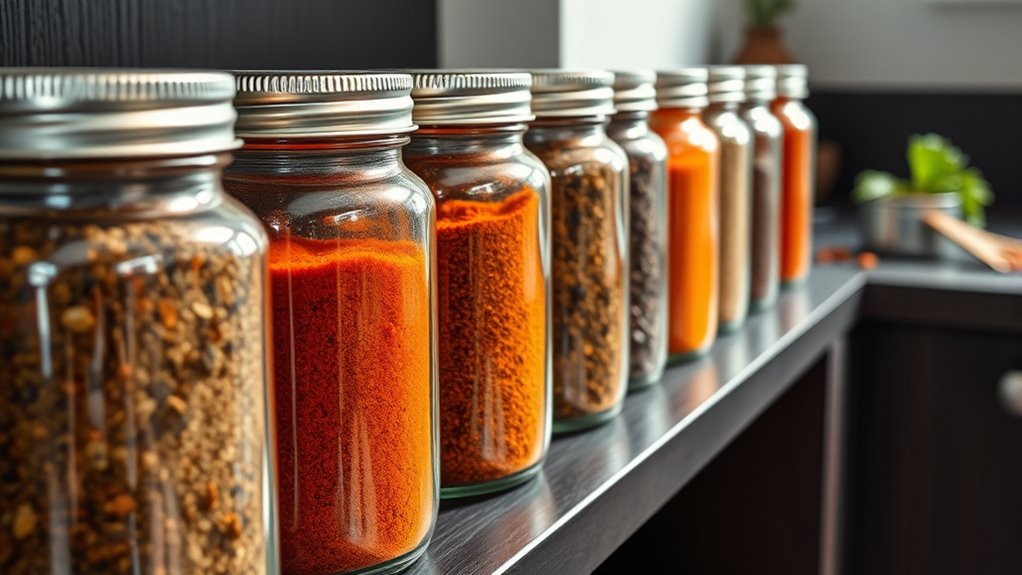
Once you’ve protected your spices from light, the next step is to guarantee they stay as fresh as possible. Using airtight containers is essential for peak freshness preservation. These containers prevent air, moisture, and odors from seeping in, which can cause spices to lose their potency and flavor. Choose containers with tight-fitting lids made of glass or high-quality plastic, and avoid flimsy or porous options. Label each container clearly to keep track of freshness, and avoid frequent opening to minimize exposure. Properly sealed spices will stay vibrant, flavorful, and ready to elevate your culinary creations whenever you need them. Additionally, storing spices in airtight containers helps maintain their aromatic compounds, which are essential for a robust flavor.
Choose the Right Location: Cool, Dark, and Dry Is Key
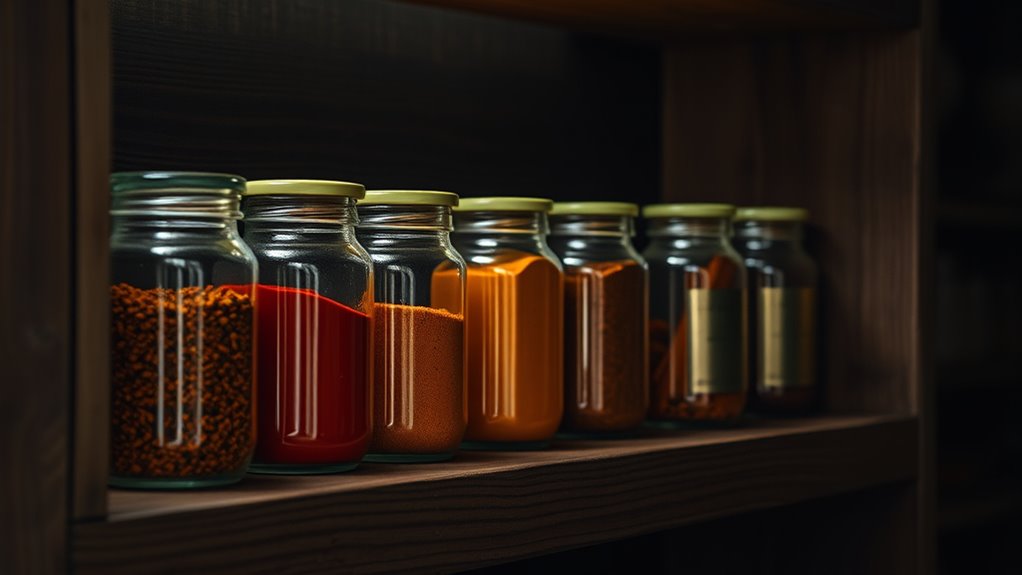
To keep your spices fresh, place them in a location that stays cool, dark, and dry. Avoid areas near heat sources or windows that let in light, which can degrade their flavor. Controlling humidity is also essential to prevent clumping and spoilage. Using proper storage conditions ensures that your spices maintain their quality for longer periods.
Keep Away From Heat
Keeping spices away from heat is essential to preserve their flavor and potency. Exposure to high cooking temperatures or fluctuating spice temperature can cause spices to lose their strong aroma and vibrant color quickly. To maintain their freshness, choose a storage spot that stays consistently cool and dry. Implementing vertical storage solutions can help keep spices organized and in optimal conditions.
- Imagine opening a jar and instantly smelling the rich, vibrant aroma that’s still as potent as when you bought it.
- Feel confident knowing your spices will last longer, saving you money and effort.
- Visualize perfectly preserved flavor enhancing every dish, no matter how simple.
- Enjoy the peace of mind that comes with storing spices in a spot shielded from heat sources like stovetops or ovens.
- Relish the convenience of having flavorful spices ready, whenever you need them, at the right spice temperature.
Limit Light Exposure
Storing spices in a location with limited light exposure helps preserve their color, aroma, and flavor over time. Light, especially UV rays, can degrade spices quickly, dulling their vibrancy and reducing potency. To combat this, use light-sensitive packaging that shields spices from harmful rays. Opt for opaque containers or jars with UV protection techniques, which block or absorb light before it reaches the spice. Keep your spice jars in a dark cabinet or pantry away from windows and direct sunlight. This simple step prevents photo-degradation and extends freshness. Additionally, incorporating digital platforms to track spice shelf life can help manage storage more effectively. By limiting light exposure, you ensure your spices stay flavorful longer, maintaining the quality you rely on in your cooking. Proper storage is key to keeping your spices vibrant and aromatic for months to come.
Control Humidity Levels
Controlling humidity levels is essential for maintaining spice quality, as excess moisture can cause clumping, mold, and loss of flavor. To achieve proper moisture control, choose a storage spot with stable ambient humidity, like a cool, dark cabinet away from sinks or ovens. Keep spices dry by avoiding areas prone to humidity fluctuations. Proper storage methods help ensure your spices stay fresh longer and retain their full flavor potential.
- Feel confident knowing you’re protecting your spices from mold and spoilage
- Enjoy fresher, more potent flavors every time you cook
- Prevent frustrating clumping that makes measuring difficult
- Reduce waste by extending your spices’ shelf life
- Create a peaceful, organized kitchen environment where your spices stay perfect
Avoid Humidity and Temperature Fluctuations
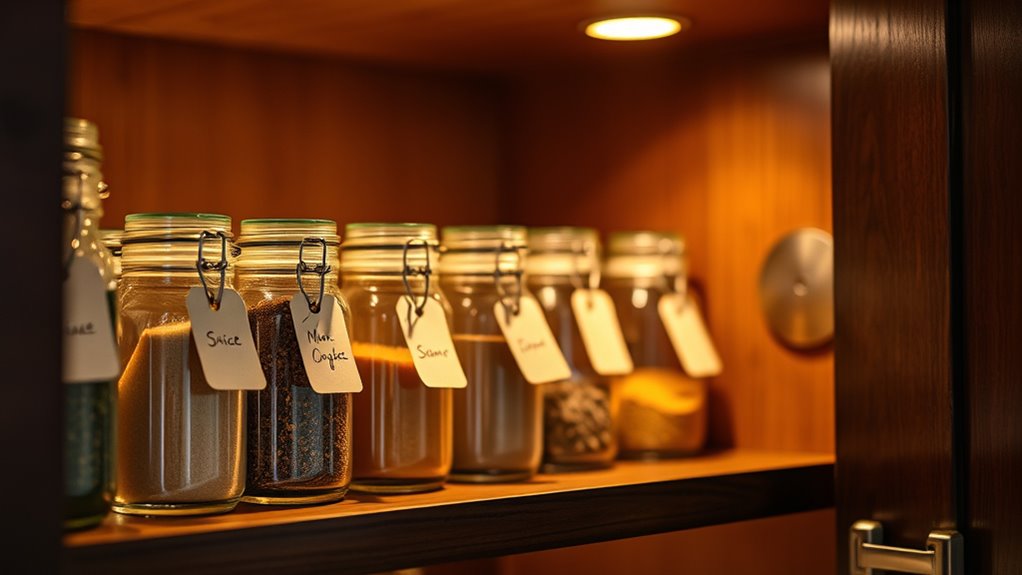
Since humidity and temperature fluctuations can cause spices to lose their flavor and potency, it’s essential to store them in a stable environment. Sudden changes in humidity can lead to clumping or mold, while temperature swings can degrade their aroma and taste. To guarantee maximum freshness, prioritize humidity control by keeping spices away from damp areas, like near sinks or stovetops. Maintain temperature stability by storing spices in a cool, dark place, away from direct sunlight or heat sources. Consistent conditions prevent the breakdown of delicate oils and preserve their vibrant flavors longer. Investing in airtight containers and keeping them in a pantry or cupboard helps shield your spices from environmental fluctuations, ensuring they stay potent and flavorful for as long as possible. Additionally, choosing quality storage solutions can further enhance the longevity of your spices.
Use Proper Labeling and Rotation Techniques
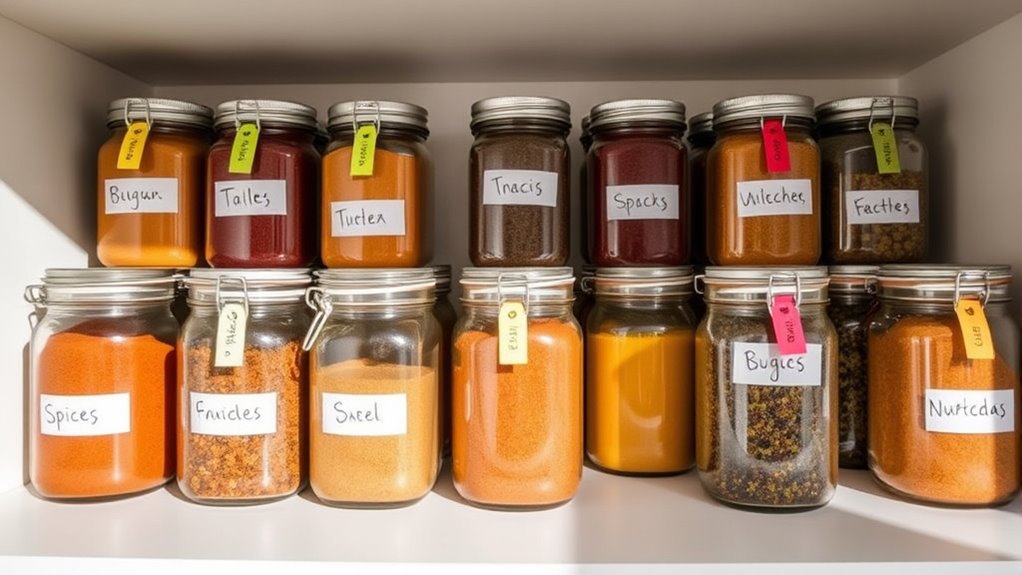
Proper labeling helps you keep track of spice freshness and prevents confusion. Using clear labels with purchase or expiration dates makes rotation easier. Always follow the first-in, first-out method to guarantee you use older spices before newer ones.
Subheading 1: Clear Labeling Practices
Have you ever wondered if your spice storage practices are as effective as they could be? Proper labeling techniques are essential for clear spice identification and maintaining freshness. When you label your jars accurately, you reduce confusion and prevent using expired spices. Consistent, visible labels help you quickly find what you need, saving time and avoiding spoilage. Remember to include the spice name, date of purchase, or expiration date for better rotation. Using bold, legible fonts and waterproof labels ensures your labels stay intact. Here are some ways clear labeling can make a difference:
- Instantly identify spices without guesswork
- Prevent mix-ups that compromise flavor
- Track freshness to avoid stale spices
- Simplify inventory management
- Keep your spice cabinet organized and inviting
Subheading 2: First-In, First-Out (FIFO)
To keep your spices fresh and flavorful, adopting a first-in, first-out (FIFO) approach is essential. This method ensures you use older spices before newer ones, reducing waste and maintaining peak flavor. Proper spice organization and inventory management are key—place newly purchased spices behind older stock and rotate regularly. Use clear labels to identify purchase dates and keep spices visible for quick access. Implementing FIFO helps prevent spoilage and keeps your pantry efficient. Here’s a simple way to visualize your spice rotation:
| Spice Name | Purchase Date | Usage Priority |
|---|---|---|
| Cinnamon | 01/2024 | Use first |
| Turmeric | 02/2024 | Use second |
| Paprika | 03/2024 | Use third |
| Cumin | 04/2024 | Use fourth |
| Oregano | 05/2024 | Use last |
This system keeps your spice collection fresh and well-managed. Regularly checking spice freshness and replacing old jars will ensure you always have flavorful spices for your tea, coffee, and kitchen craft needs.
Keep Coffee and Tea Separate From Spices to Prevent Flavor Cross-Contamination
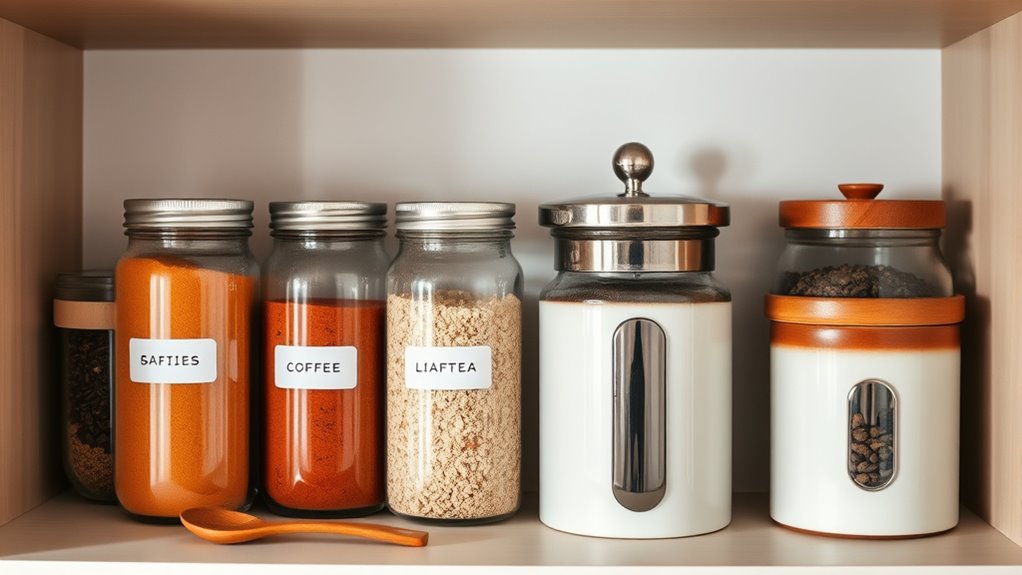
Since spices can easily absorb odors, keeping coffee and tea separate from them is essential to prevent flavor cross-contamination. If your coffee storage and tea container options aren’t well-isolated, you risk dulling their unique flavors. To maintain freshness, store coffee beans away from spices, preferably in airtight containers. Use dedicated tea containers to avoid scent transfer. Imagine brewing a fragrant cup of coffee or tea, only to find it tainted by lingering spice aromas—that’s frustrating. Proper separation preserves the integrity of your beverages and spices. Additionally, choosing the right storage solutions can further enhance the freshness and prevent aroma transfer.
Understand the Shelf Life of Different Spices and Herbs
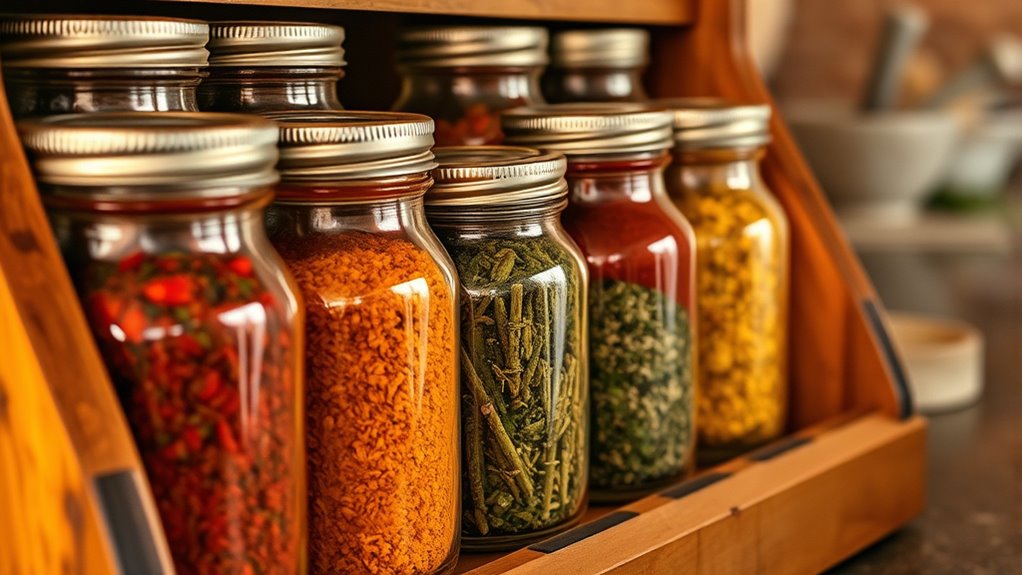
Understanding how long spices and herbs stay fresh is key to keeping your kitchen flavorful. Spice aging varies, with ground spices typically losing potency faster than whole ones. Herbs, especially fresh ones, have shorter herb longevity and should be used sooner. Dried spices usually last between 1 to 3 years, but their flavor diminishes over time, making older spices less aromatic and potent. Whole spices can last longer, often up to 4 years, if stored properly. Knowing the shelf life of each spice helps prevent using dull, ineffective flavors. Regularly check for signs of spoilage like discoloration, off smells, or clumping. Proper storage extends spice aging, ensuring your seasonings remain vibrant, fragrant, and effective in your culinary creations. Additionally, understanding climate control can help optimize storage conditions, maintaining spice freshness for longer periods.
Grind Spices Just Before Use for Best Flavor
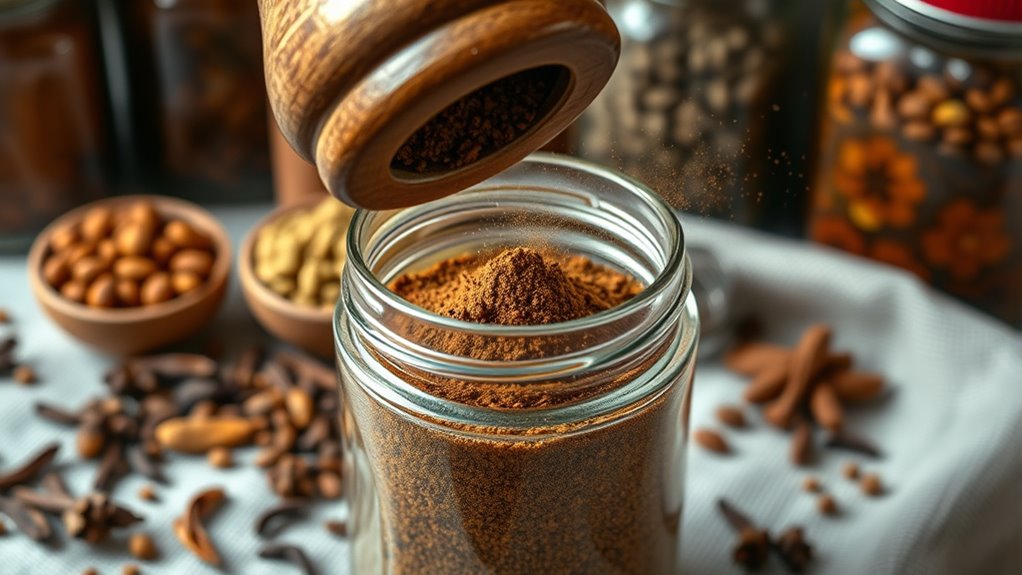
Freshly ground spices deliver a burst of flavor that pre-ground varieties can’t match. By doing your spice grinding just before use, you maximize flavor preservation and guarantee vibrant taste in every dish. The aroma is more intense, and the nuanced notes of each spice shine through. Plus, grinding fresh spices lets you control the coarseness, tailoring it to your recipes. When you grind spices on demand, you avoid the staleness that comes with pre-ground options. This simple step elevates your cooking and keeps your dishes lively and aromatic. Remember, fresh spice grinding isn’t just about flavor—it’s about creating a sensory experience that transforms ordinary ingredients into extraordinary meals.
- Reveals maximum flavor and aroma
- Keeps spices vibrant and fresh
- Preserves delicate oils and nuances
- Enhances the sensory experience
- Adds a personal touch to every dish
Regularly Check and Dispose of Old or Stale Spices
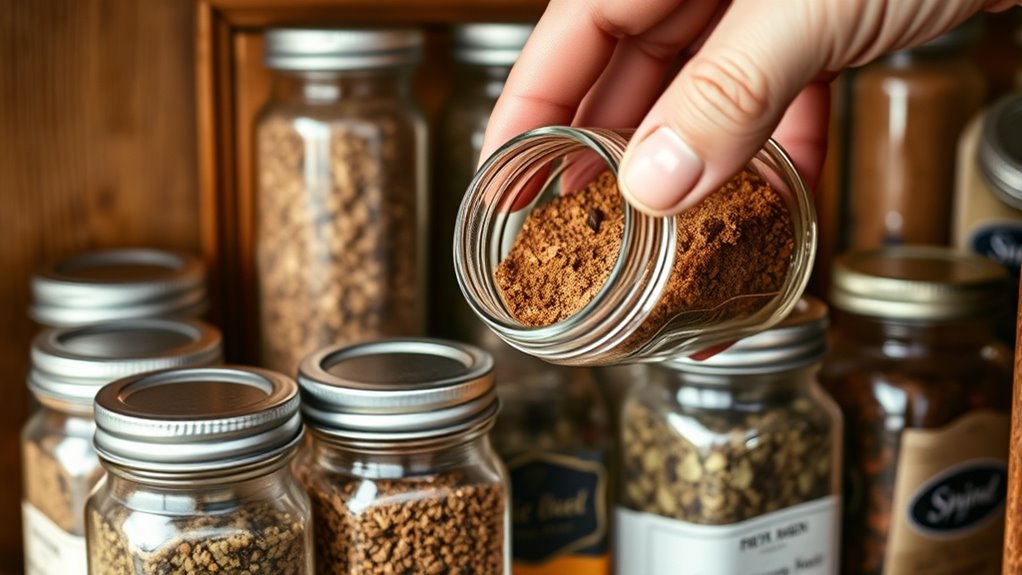
Regularly checking your spice stash is essential to guarantee you’re using flavors at their peak. Over time, spices lose their potency, so keep your spice shelf organization in check by inspecting your spice storage containers regularly. Discard any spices that look dull, have changed color, or emit a stale odor. This helps prevent stale flavors from contaminating fresh spices and ensures your dishes stay vibrant. Use clear, labeled spice containers to easily identify when a spice is nearing expiration. By removing old spices, you create space for new ones and maintain a well-organized, efficient spice collection. Staying vigilant about spice freshness not only enhances your cooking but also extends the shelf life of your entire spice collection.
Frequently Asked Questions
Can Spices Be Stored in the Freezer to Extend Freshness?
Yes, you can store spices in the freezer for better spice preservation. Freezer storage slows down the degradation process, keeping your spices fresher longer. Just make sure to use airtight containers or resealable bags to prevent moisture and odor transfer. When needed, take out only what you’ll use to avoid repeated freezing, which can affect flavor. Freezing is an effective way to extend spice freshness while maintaining their vibrant flavors.
How Do Different Spice Types Require Different Storage Methods?
Storing spices is like caring for different types of treasures—you adapt your approach. For herbs versus seeds, keep herbs in airtight containers away from light, while seeds like cumin stay cooler and dark. Dried spices last longer in a dark, dry place, but fresh spices need refrigeration or freezing. Know that dried spices are more durable, but fresh ones require quicker use, much like tending to delicate plants.
What Are the Signs That Spices Have Gone Bad?
You’ll notice spices have gone bad when their aroma weakens or disappears altogether, signaling loss of flavor. Discoloration of spices, such as duller or faded hues, is another clear sign they’ve spoiled. If your spices smell off or have an unusual taste, it’s best to discard them. Fresh spices should have a vibrant aroma and color; if these fade, it’s time to replace them for ideal flavor.
Is It Better to Buy Whole Spices or Ground Spices for Longevity?
If you want your spices to stay fresh and flavorful, go for whole spices rather than ground. Grinding your own keeps the freshness preservation high and flavor retention maxed out, so you don’t end up with dull, lifeless seasoning. Buying whole spices might be a pain, but think of it as investing in a more vibrant kitchen—your taste buds will thank you for the extra effort.
How Do I Prevent Pests From Contaminating Stored Spices?
To prevent pests from contaminating your stored spices, keep them in airtight containers made of glass or metal, and store them in a cool, dry place. Regularly check for signs of pests or contamination risks, and avoid using spices past their expiration date. Consider adding bay leaves or dried lavender to your spice containers, as these natural pest prevention methods can help keep unwanted critters out and maintain freshness longer.
Conclusion
By following these simple storage tips, you’ll keep your spices, coffee, and tea bursting with flavor for longer. Think of your spice collection as a treasure chest—protect it from light, humidity, and air to conserve its true essence. After all, isn’t the magic of a great dish or brew worth a little extra care? With mindful storage, you ensure every pinch and sip remains as vibrant as your culinary dreams.
